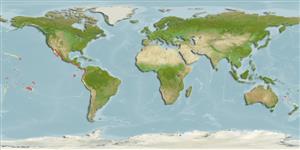Environment: milieu / climate zone / depth range / distribution range
Ekologi
marina bottenlevande; djupintervall 10 - 120 m (Ref. 92840). Subtropical
Eastern Central Pacific: Gulf of California to Ecuador.
Size / Vikt / Age
Maturity: Lm ? range ? - ? cm
Max length : 14.0 cm SL hane/ej könsbestämd; (Ref. 92840)
Short description
Bestämningsnycklar | Morfologi | Morfometri
Distinguished by the following characteristics: laterally compressed head and body; large mouth and very oblique; completely scaled body with ctenoid scales; first dorsal with VII spines; pelvic fins fused forming a disc; caudal fin lanceolate (Ref. 92840).
Inhabits muddy bottoms at depths ranging from 10-120 meters (Ref. 92840).
Life cycle and mating behavior
Maturities | Reproduktion | Spawnings | Egg(s) | Fecundities | Larver
Patzner, R.A., J.L. Van Tassell, M. Kovačić and B.G. Kapoor, 2011. The biology of gobies. Enfield, NH : Science Publishers ; Boca Raton, FL : DIstributed by CRC Press, 685 p. (Ref. 92840)
IUCN Red List Status (Ref. 130435)
Threat to humans
Harmless
Human uses
Verktyg
Special reports
Download XML
Internet-källor
Estimates based on models
Preferred temperature (Ref.
123201): 16.2 - 26.9, mean 20.8 °C (based on 45 cells).
Phylogenetic diversity index (Ref.
82804): PD
50 = 0.5005 [Uniqueness, from 0.5 = low to 2.0 = high].
Bayesian length-weight: a=0.00708 (0.00333 - 0.01504), b=3.09 (2.92 - 3.26), in cm total length, based on LWR estimates for this (Sub)family-body shape (Ref.
93245).
Trofisk nivå (Ref.
69278): 3.4 ±0.4 se; based on size and trophs of closest relatives
Resiliens (Ref.
120179): Hög, lägsta populationsfördubblingstid mindre än 15 månader (Preliminary K or Fecundity.).
Fishing Vulnerability (Ref.
59153): Low vulnerability (10 of 100).
